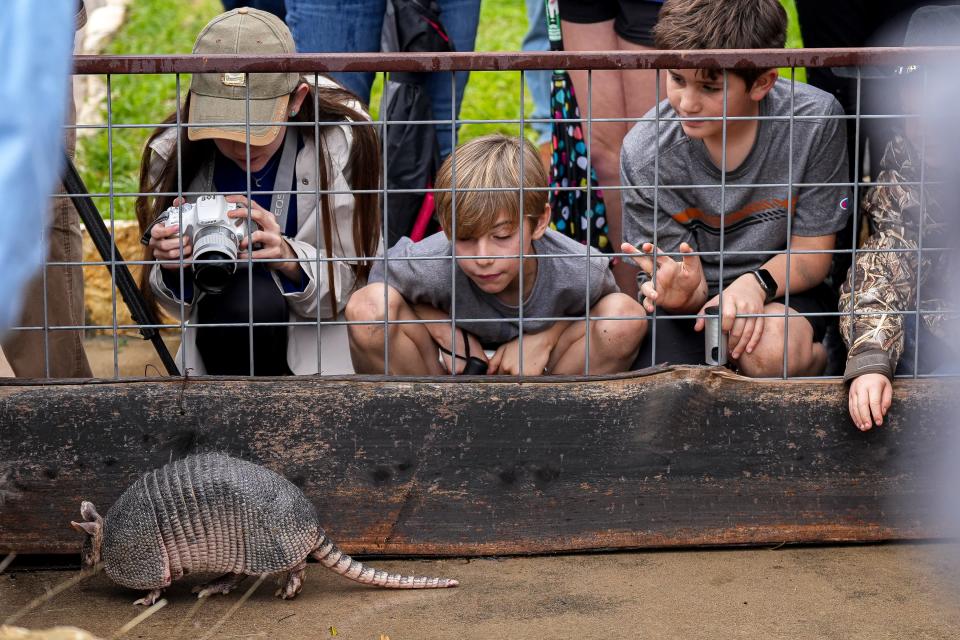Video captures rare sighting of armadillo quadruplets. Here's 8 facts you may not know
You may or may not know that the armadillo is Texas' official small mammal. Did you know that, despite popular belief and depictions in the media, most armadillo species can't roll into a ball?
Do you know all of these armadillo facts? Here's a brief list of things you may not know.
Armadillo means 'little armored one' in Spanish
The mammal's "armor" is composed of keratin-covered bony plates that form the shell. This distinctive shell offers protection from predators.
There are 21 known species of armadillos
Armadillos are identified by the number of armored bands covering the back, head, legs and tail. These species also vary widely in size. The smallest is the pink fairy armadillo, which is about six inches long and weighs approximately three ounces, National Geographic reports. The largest species, appropriately called the giant armadillo, averages five feet long and 60 pounds ― however, one captive specimen has been measured at 180 pounds.
The nine-banded armadillo, which is the size of a cat or small dog, is the only species found in the U.S. With the exception of East Texas' Trans-Pecos, nine-banded armadillos can be found throughout the state, according to the Texas Parks & Wildlife Department. Another key feature of this species is its claws, which are used to dig up insects and larvae for food, as well as to burrow dens.
Nine-banded armadillos always birth identical quadruplets
An armadillo's lifespan varies from seven to 20 years, giving birth once a year in the spring. The mammal may begin reproducing after reaching sexual maturity at approximately one year of age. Following a gestation period of two to five months, females typically give birth to between one and 12 baby armadillos, which are called pups.
Nine-banded armadillos are the only mammals that always give birth to litters of four, all of which are either male or female. The seven-banded armadillo births between eight and 15 identical pups with each litter. The pups are born fully formed with their eyes open, according to TPWD.
Better than a groundhog: As a weather forecaster, armadillo Bee Cave Bob in Texas isn't too hung up on accuracy

Most armadillos can't roll into balls
Only two species of armadillo can roll into a ball: the Brazilian and Southern three-banded armadillos, which belong to the Tolypeutes genus. Armadillos with more plates lack the flexibility required to achieve this position.
Armadillos are good swimmers
Even with heavy shells, armadillos have mastered the art of water travel. As their shells cause the mammal to sink, it simply chooses to walk across the bottom of narrow streams, aided by the ability to hold in breath for four to six minutes. To navigate larger bodies of water, armadillos swallow enough air to inflate their stomachs to twice normal size in order to increase buoyancy, or ability to float. It can then take them hours to release the excess air.
Armadillos sleep up to 16 hours a day
If you struggle to claim the recommended eight hours of sleep per night, you may covet the armadillo's ability to sleep twice that amount. The nocturnal mammals spend more of their waking hours foraging than most, according to Treehugger. Their lack of hair may account for the creatures' odd schedules. Without hair to regulate body temperature, nine-banded armadillos tend to forage on summer evenings and warm afternoons, TPWD reports.
Apparently, this dedication to feeding is exhausting because armadillos can then sleep for up to 16 hours per day.

Armadillos have dinosaur ancestors
You read that right — scientists have found armadillos evolved from glyptodonts, dinosaurs so big they would make a giant armadillo seem like a puppy. Weighing as much as one or two tons, glyptodonts went extinct in the Americas at the close of the last ice age, according to the American Museum of Natural History.
Armadillos spread leprosy
Armadillos are the only nonhuman animals recorded to have leprosy, now known as Hansen's Disease. Scientists believe the mammal's low body temperature is ideal for the bacteria that causes the disease. Contrary to what you might expect, humans were the ones to give Hansen's Disease to armadillos: Experts believe armadillos were initially infected by 15th-century explorers.
This article originally appeared on Austin American-Statesman: Video captures rare sighting of armadillo quadruplets in Texas

